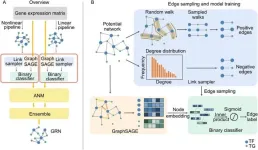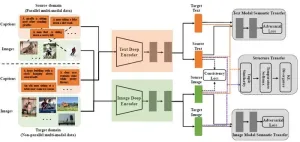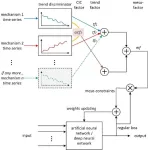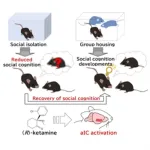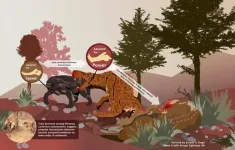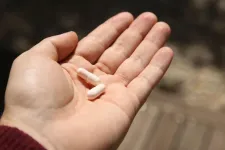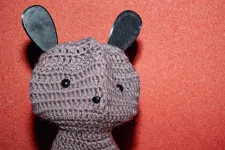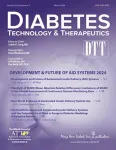Using mussels and silkworm cocoons to stop organ bleeding
2024-02-23
(Press-News.org) In recent news, there has been a case where a patient experienced pain due to a surgical procedure involving sutures, resulting in the unintended presence of gauze within the patient's body. Gauze is typically employed to control bleeding during medical interventions, aiding in hemostasis. However, when inadvertently left in the body, it can lead to inflammation and infection. Addressing this issue, recent research has been published by researchers focusing on a hemostatic agent derived from mussels and silkworm cocoons. This hemostatic agent has garnered attention in the academic community due to its efficacy in clotting blood and its safety within the body.
A collaborative team, led by Professor Hyung Joon Cha (Department of Chemical Engineering and the School of Convergence Science and Technology) and Dr. Jaeyun Lee (Department of Chemical Engineering) at Pohang University of Science and Technology (POSTECH), Professor Kye Il Joo (Department of Chemical Engineering and Materials Science) at Ewha Womans University, and Dr. Jong Won Rhie (Department of Plastic and Reconstructive Surgery) at Seoul St. Mary's Hospital of the College of Medicine at the Catholic University of Korea, has developed a bilayer nanofiber membrane hemostat using natural proteins derived from mussels and silkworm cocoons. The findings of this research have been recently published online in the latest issue of Small, an international journal specializing in nanoengineering.
Conventional hemostatic agents such as gauze or medical bands are limited to application on the surface of the skin. Although there are certain materials that naturally degrade within the body like fibrin glue and collagen sponges, they necessitate proteins sourced from humans or animals, making them considerably expensive. Moreover, existing hemostatic materials lack consistent adherence to bleeding sites and are prone to infection from external contaminants.
In response, the researchers developed a bilayer adhesive hemostat utilizing mussel adhesive proteins that exhibit strong tissue adhesion underwater and silk fibroin extracted from silkworm cocoons. In the research, mussel adhesive proteins demonstrated excellent hemostatic effects including platelet activation. The researchers employed methanol vapor to modify the secondary structure of silkworm silk proteins, resulting in a nanofiber membrane with a hydrophobic outer surface.
In light of this, the team engineered a hemostatic agent featuring an inner layer with mussel adhesion proteins for wound adhesion and an outer protective layer entirely composed of silkworm silk proteins. Through animal experiments, the hemostatic agent demonstrated rapid acceleration of tissue adhesion and hemostasis in bleeding wounds, effectively preventing the infiltration of water containing infectious agents such as bacteria. Using two proteins that are both highly biocompatible and biodegradable, the researchers have introduced a novel hemostatic agent capable of clotting blood and providing defense against infection.
Professor Hyung Joon Cha of the POSTECH who led the study remarked, "We have validated the exceptional hemostatic performance of a multifunctional topical adhesive hemostatic agent that is derived from nature and is based on degradable proteins in the human body." He added, "We will continue further research to assess its applicability in real-world patient care or surgical settings."
The research was conducted with support from the Marine BioMaterials Research Center Program of the Ministry of Oceans and Fisheries and the Mid-Career Research Program of the National Research Foundation of Korea.
END
[Attachments] See images for this press release:

ELSE PRESS RELEASES FROM THIS DATE:
2024-02-23
A new research study led by A*STAR.Singapore Immunology Network (A*STAR.SIgN) has found that neutrophils—one of the most abundant white blood cells in our body—change drastically in certain cancers, adopting a new function whereby they promote tumour growth. By carefully studying neutrophils as soon as they enter the tumour, scientists from A*STAR.SIgN also uncovered ways to accurately differentiate tumour-promoting neutrophils from normal neutrophils present in the rest of the body. Neutrophils play important and irreplaceable roles in fighting infections, ...
2024-02-23
Gene regulatory networks (GRNs) depict the regulatory mechanisms of genes within cellular systems as a network, offering vital insights for understanding cell processes and molecular interactions that determine cellular phenotypes. Transcriptional regulation, a prevalent type for regulating gene expression, involves the control of target genes (TGs) by transcription factors (TFs). One of the major challenges in inferring GRNs is to establish causal relationships, rather than just correlation, among the various components ...
2024-02-23
Image-sentence retrieval task aims to search images for given sentences and retrieve sentences from image queries. The current retrieval methods are all supervised methods that require a large number of annotations for training. However, considering the labor cost, it is difficult to re-align large amounts of multimodal data in many applications (e.g., medical retrieval), which results in unsupervised multimodal data.
To solve the problem, a research team led by Yang YANG published their new research on 15 Feb 2024 in Frontiers of Computer Science co-published by Higher Education Press and ...
2024-02-23
Deep learning modeling that incorporates physical knowledge is currently a hot topic, and a number of excellent techniques have emerged. The most well-known one is the physics-informed neural networks (PINNs). PINN integrates the residuals of the system’s governing partial differential equations (PDEs) and the initial value/boundary conditions into the loss function, thus the resulting model satisfies the constraints of the physical laws represented by the PDEs. However, PINN cannot work if equations among the key physical quantities of the system have not been established. To ...
2024-02-23
Osaka, Japan – Well-being is important for everyone, especially when we feel lonely or isolated. Depression is a serious challenge for many people and finding an effective solution is key.
In a recent study published in Molecular Psychiatry, researchers from Osaka University used a mouse model of depression to reveal that one form of ketamine (a common anesthetic) in low doses can improve social impairments by restoring functioning in a specific brain region called the anterior insular cortex.
Ketamine is often used at low doses to treat depression, but its actions in the brain remain relatively unclear. Generally, ketamine refers to a mix of two different forms of ketamine: ...
2024-02-23
The evolutionary success of the first large predators on land was driven by their need to improve as killers, researchers at the University of Bristol and the Open University suggest.
The forerunners of mammals ruled the Earth for about 60 million years, long before the origin of the first dinosaurs. They diversified as the top predators on land between 315–251 million years ago.
Researchers studied the jaw anatomy and body size of carnivorous synapsids, using these traits to reconstruct the likely feeding habits of these ancient predators and chart their ecological ...
2024-02-23
AI holds the potential to revolutionize healthcare, but it also brings with it a significant challenge: bias. For instance, a dermatologist might use an AI-driven system to help identify suspicious moles. But what if the machine learning model was trained primarily on image data from lighter skin tones, and misses a common form of skin cancer on a darker-skinned patient?
This is a real-world problem. In 2021, researchers found that free image databases that could be used to train AI systems to diagnose skin cancer contain very few images ...
2024-02-23
Increased use of Paxlovid, the antiviral drug used to treat COVID-19, could prevent hundreds of thousands of hospitalizations and save tens of billions of dollars a year, according to a new epidemiological model published by researchers at The University of Texas at Austin. In fact, epidemiologists found that treating even 20% of symptomatic cases would save lives and improve public health.
A 2023 National Institutes of Health study found that only about 15% of high-risk patients take Paxlovid when infected with COVID-19. Using a multiscale mathematical model based on ...
2024-02-23
From smart virtual assistants and self-driving cars to digital health and fraud prevention systems, AI technology is transforming almost every aspect of our daily lives—and education is no different. For all its promise, the rise of AI, like any new technology, raises some pressing ethical and equity questions.
How can we ensure that such a powerful tool can be accessed by all students regardless of background?
Inspired by this call to action, USC researchers have created a low-cost, accessible learning kit to help college and high school students build their own “robot friend.” Students can personalize the robot’s ...
2024-02-23
A special 13-article supplement to the peer-reviewed journal Diabetes Technology & Therapeutics (DTT) examines the “Development and Future of Automated Insulin Delivery (AID) Systems. Click here to read the supplement now.
Included in the supplement is the article titled “A Peek Under the Hood: Explaining the MiniMed™ 780G Algorithm with Meal Detection™ Technology", by Benyamin Grosman, PhD and his Medtronic algorithm team with co-authors Ohad Cohen, MD, and Robert Vigersky, MD, Chief Medical Officer at Medtronic. James Thrasher, MD “Early ...
LAST 30 PRESS RELEASES:
[Press-News.org] Using mussels and silkworm cocoons to stop organ bleeding

